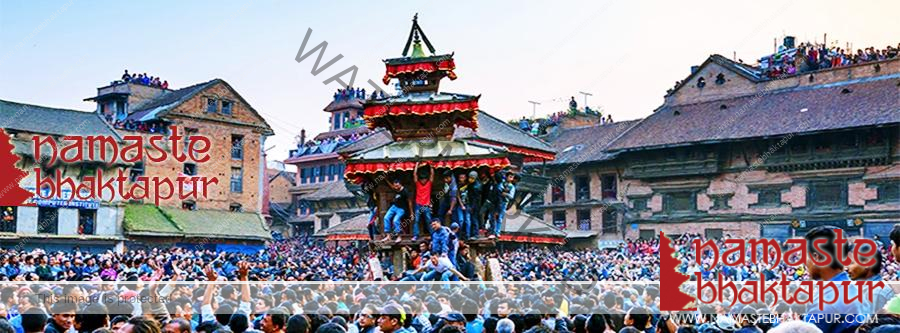BISKA: JATRA (10-April 2023 to 19-April 2023)
Biska Jatra (Bisket Jatra)(बिस्काः जात्रा): Grand Festival of Bhaktapur
The emergence of the Biska Jatra (Bisket Jatra) landmarks the cultural ecstasy in Bhaktapur. Prominently observed on the advent of spring it is a festival of human emotions. The human emotions are symbolically depicted on multiple aspects of the festival at large. The folk-lore as it tells about the slaughtering of a pair of snakes by a handsome youth bestowed with Tantric empowerment is the central point of the festival. It is said that two serpents came out of the nostrils of a beautiful princess at mid night while sneezing. They grew to a huge shape in the twinkling of an eye and took the life of these persons who slept with the princess. As always the serpents were about to sting one of the youthful persons in the hot bed, one night the meticulous person caused the serpents breathe their last with his Tantric power.

Having found the person alive and the serpents dead, the following morning, Bishwo Malla the then ruler brought the practice of hoisting two long flags on a big long wooden pole. Symbolically enough the banners meant for hoisting the flags were addressed- Yoshin- the pole of love and remained popular among the local people as of these days. The hoisting of the serpent shaped flags in annually observed with great enthusiasm. The banners are also known as BISHWO DHOJA after Bishwonath Bhairab, the main god of the festival.

The mythical belief considers the firmament and the earth as the devine male and female object in the form of Bhairab and Bhadrakali respectively. It says that the mating between the sky and the earth has made the creation possible on our planet. The rain that showers from the sky to the earth are considered the life giving element and the earth is the creative base. And the hole in which the Yoshin-Pole is erected is the symbol of the female reproductive organ. So, the Biska is also a festival of the mating of the Bhairab and Bhadrakali. The metallic icon of Bhairab and the Bhadrakali is brought out of the temples temples four days earlier to the erection of the Yoshin Pole. They are enthroned on the respective chariots called the Bhaila Kha (Chariot) and the Nakinju Kha. The Bhailakha and Nakinjukha are voluntarily drawn by the festival people with great excitement. The Bhairab and Bhadrakali are respectively addressed as Bhaila Dyo and Nakinju Ajima in local dialect. Essentially the concept of the festival is based on conjugality, creation and continuity of life.

On the last day of the year by the evening the Bhairab and Bhadrakali chariots are drawn toward Yoshin-Khyo where the Yoshin-Pole is erected by the late evening. A mammoth crowd participates with lots of enjoyment and exclaims joy. The energetic youths tend to reach the top of the pole climbing up the big dangling ropes aiming to pick up green shrubs adjusted on the top. The treat behind the endeavors is furnished with a belief; if one who could pick up the green shrub from the top of Yoshin-Pole is the lucky one for a male child to gibe forth. The pole remains perpendicular to the sky and earth the earth for 24 hours. And the evening is followed by big feast all over Bhaktapur. The dawn of the New-year turns to a joyous moment of all the citizens of Bhaktapur. Most of them get assembled to the Yoshin Khel (South East from Nyatapola Temple) in early hours of the morning. Paying homage and sacrificial worship to the Bhairab and the Bhadrakali become the scenario of the morning through mid-day eve. The cheerful appearance and the festive gala signify voluptuous moment of life on the advent of the New Bikram Era B.S.(BIKRAM SAMBAT).

The Yoshin Pole is pulled down to the ground by the evening. Mammoth crowd assembled on the eve, give expression to their joyful mind with the seasonal melodies enchanting every now and then. Seasonal tunes are Flutes, Drums, Cymbals and other musical instruments and attractive features of the event. People get concentrated to pull the Bhairab and the Bhadrakali chariots. They are pulled towards the GAHITI TOLE . At midnight the Bhairab and Bhadrakali chariots are collided symbolizing copulation. But this time the Bhairab chariot does not move even a single inch. It is the Bhadrakali who keeps passionately dashing over the Bhairab at mid night.
 Bhaktapur
Bhaktapur